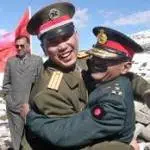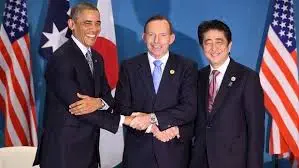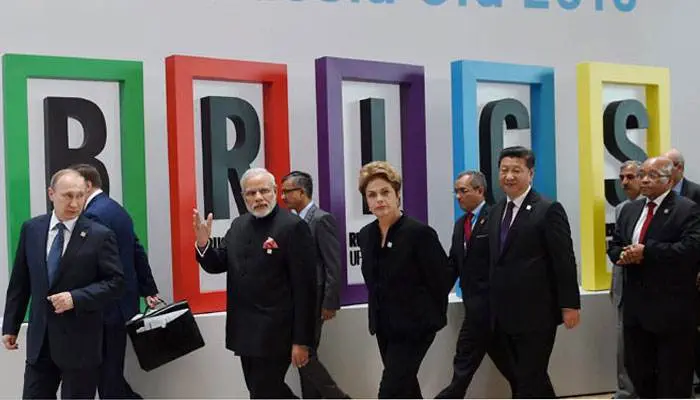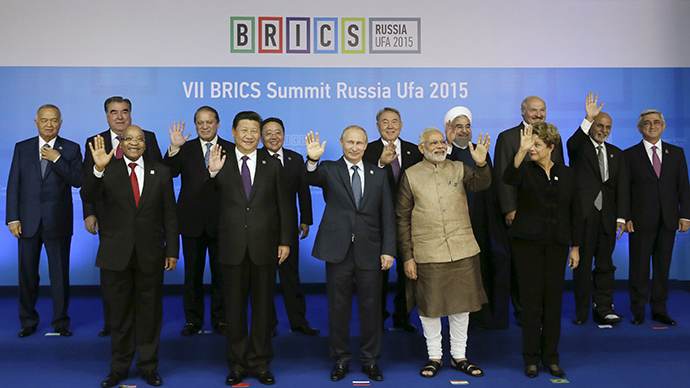Pradeep Kanthan 25 September 2014
A visit to remember
Foreign dignitary visits are invariably announced as ‘cordial’, ‘successful’ and the promise of a great relationship in the future. Couched in diplomatic language and show-casing the host’s ability in a positive light, these meetings seldom have significance unless they are a solution to a major conflict. Trade and confident building measures seem to be worthwhile reasons provided they are genuine.
 In the case of China there is ambiguity when visits take place synchronised with border tensions.
In the case of China there is ambiguity when visits take place synchronised with border tensions.
President Xi’s visit to the South Asian region is amply clear and lays bare Chinese intentions despite any ‘Modi’fications. The body language of the visit is evident, much more than the diplomacy and signing of sister city agreements. There are subtle economic and military messages in the visit despite the Chinese claim that the visit seeks to dispel any fears of a ‘rising China’.
(Wang Dehua, a South Asian affairs expert at the Shanghai Institute for International Studies, tells the Global Times’ Chinese edition that Mr Xi’s trip to the region, particularly to India, will “dispel worries from the neighbouring countries over China’s rise”
I don’t think there is a concern over the rise of China. It is the medieval diplomacy, a gunboat or border incursion diplomacy that is irksome and non-productive.
Chinese insinuations and innuendos
Xi’s visit to Sri Lanka and Maldives, normally should not raise any hackles. However, these are South Asian Association for Regional Cooperation (SAARC) countries and China is seeking to become a member from being an observer in the SAARC. This is their counter-argument to India’s attempts for the same with the Shanghai Cooperation Organisation (SCO). The organisation has China, Russia, and the Central Asian States. The aims and purposes of both these organisations are quite different. China has no direct role in regional economic cooperation in the SAARC, while India may be relevant in a regional security environment in the SCO.
Is Xi’s visit to South Asian countries blatantly in the face of India’s position as the regional hegemon? A riposte to Modi’s tour of Japan?
Japan’s Shinze Abe’s earlier visit to Bangladesh and Sri Lanka heightens the race for influence within the South Asian region, bringing in the North Asian security environment to the region.
Why is there a sudden renewed interest in the South Asian region?
After having forays into the African and Latin American markets, the South Asian region is an emerging market for Chinese goods and services. It has always been one. China actively seeks economic domination of the region through FTAs and cross border trade. While this may appear a genuine quest for more business, it has the potential of making the Yuan dilute regional currencies. India will be the first to capitulate because of shared borders with China. The growth of the Yuan in the border areas (like it has happened in the case of Vietnam) coupled with PLA incursions could destabilise the currency and security of the region.
Further, the ability to dump consumer goods will affect manufacturing and employment in the target countries. FTAs generally are to the benefit of the larger partner or the more technically advanced one. FTAs are debatable and can lead to varying unequal results, tipping the balance of trade in favour of the stronger party. While this may be a generalisation, it is hard to quote a successful one. Regional cooperations such as ASEAN that address all issues seem to be successful in promoting harmony and growth in the region. SAARC should aim to become like ASEAN. China’s entry into the region only reduces the prospects. Bilateral trade is the way to go and again there is the unavoidable risk of the balance of trade tipping on the side of China. These processes require complex rules of origin and agreements that can be respected or enforced from both sides, which can only happen in a mutually conducive environment.
 China wages a trade war akin to the border incursions. If you recall a consignment of defective pharmaceutical goods sent from a Chinese port to Nigeria marked ‘Made in India’. (http://pib.nic.in/newsite/erelease.aspx?relid=49125) . There are more such examples. While the Chinese Government punishes its citizens who indulge in such activities, it seldom doesn’t prevent it. Making the position of the state independent of its people as expected in totalitarian regimes.
China wages a trade war akin to the border incursions. If you recall a consignment of defective pharmaceutical goods sent from a Chinese port to Nigeria marked ‘Made in India’. (http://pib.nic.in/newsite/erelease.aspx?relid=49125) . There are more such examples. While the Chinese Government punishes its citizens who indulge in such activities, it seldom doesn’t prevent it. Making the position of the state independent of its people as expected in totalitarian regimes.
After a seemingly cordial visit, Xi chooses to make statements such as asking the PLA to be strong enough to handle regional wars. Perhaps he meant to isolate his statements to cyber warfare but nevertheless has been indifferent to regional neighbour’s sentiments. Perhaps lost in translation?
The visit to SAARC countries must be seen in conjunction with the border intrusions in the Leh region at the same time. India had to deploy 1,500 troops to counter the move by 600 PLA troops supporting wanton intrusions. This was all over the news only in the Indian media. There is not a word of it anywhere else. A look at Xinhua covers Xi’s visit in a very perfunctory way. There definitely is no talk of border incursions. The Chinese and Indians view these intrusions differently. India’s protests are replied with an indifference trivialising or ignoring the incursions. As an example, below is an extract from the briefings of the Chinese Foreign Ministry, which is just diplomatese!
In July this year, General Bikram Singh visited China, and there followed a Chinese Foreign Ministry Spokesperson Hong Lei’s Regular Press Conference on July 4, 2014. Here is the question and answer relating to border incursions:
“Q: General Bikram Singh, Chairman of the Chiefs of Staff Committee of the Indian armed forces and Chief of Army Staff of the Indian Army who is visiting China, held talks with some Chinese leaders yesterday. Can you brief us on their talks? Have they talked about the Chinese army’s entry into disputed border areas between China and India?
A: Fan Changlong, Vice Chairman of China’s Central Military Commission met with General Bikram Singh, Chairman of the Chiefs of Staff Committee of the Indian armed forces and Chief of Army Staff of the Indian Army on July 3. Chief of the General Staff Fang Fenghui held talks with him. Executive Vice Foreign Minister Zhang Yesui met with him as well.
Vice-Chairman Fan Changlong pointed out during the meeting that both China and India are major developing countries boasting time-honoured civilization. The two countries are each other’s important neighbours, whose common interests far outweigh their differences. We believe that China and India have enough wisdom and capacity to properly deal with historical difficulties. Military-to-military relationship is an important component of bilateral relations. Military on both sides should translate consensus reached by leaders of the two countries into concrete results, promote strategic mutual trust, enhance practical cooperation, properly manage differences and build a military-to-military relationship compatible with China-India strategic partnership of cooperation. China is ready to push for new progress of military-to-military relations with India.
General Singh said that the Indian side highly values its relations with China and stands ready to deepen cooperation with China in various fields and increase communication at multiple levels, so as to jointly safeguard peace and tranquillity in the border areas and further elevate military-to-military relationship.”
Possible reasons for behaviour
This is the closest reasoning one can get of the border incursions. There can only be some reasons for such blindness on the part of the Chinese for what India considers an assault on its sovereignty, such as:
(a) Border incursions really are a result of a lack of proper demarcation, as the Chinese leaders want us to believe.
(b) China wants to dominate the region after having a claim over swathes of Indian territory. This is more in line with the Chinese cloak and dagger methods. It believes in aggressive postures and later sheepishly withdrawing. All choreographed alongside visits by dignitaries. (An animal instinct when the alpha of the species marks its territory, ready for a spat with other alphas. This perhaps born out of deep insecurity).
(c) A lack of recognition of India as an equal partner. This can be cited as a major reason, as China looks at India as a market and an insignificant yet potential security threat. Further, with the uncertain situation in Pakistan, the potential for trade and investment is on the wane. Therefore It remains China’s ally of convenience only to counter India.
Military solutions in the absence of political ones?
There seems to be no solution to the irksome situation with China, except possibly a military one. This is an option that India must seriously consider with lesser regard to the consequences of such action. It will be Dharma to the nation and people. If we don’t return the ‘fire’ it will be considered a weakness. In many ways, the 1962 India-China War, despite severe comment and negative results, has been to India’s advantage and put the Chinese on the back foot … constantly worried about real engagement with India.
Reasons and possible solutions to situations
Here are some reasons and possible solutions for their incursions and hostile behaviour:
- The impression that the Chinese system has the People’s Liberation Army (PLA) as the ultimate controller of the Chinese state belies the reality that the PLA is the army of the Party and not the country. It does the Party’s bidding. Historically, whoever controlled the Middle Kingdom was the ruler of China. It lies literally in a ‘central’ concept. Foreign trade and foreigners were kept at bay, far from the seat of the Emperor. Thus their mechanics of preventing a foreign invasion shapes their foreign policy. The insecurity of the Party is rooted in history relying on pre emptive diplomacy rather than a reactive one.
- The fact is that the PRC was born out of warlord-ism, in which they unfortunately still believe in and therefore incursions and brute methods are to be expected despite the veneer of business suits and diplomatic talks. Externally aggressive, internally deep insecurity.
- Falun Gong, Tibet, and liberation movements make them uneasy. They are not a democracy and their need to be in power is the chink in their armour. Given China’s attitude, I don’t see why the Free Tibet protests before the consulates should be curbed. In fact, the Falun Gong must be encouraged in India.
- The PLA shows its aggressive behaviour with Japan, the US, and all its neighbours in a primeval way. It is their style. In the case of Russia, it has suffered militarily. They had treaties with the British over Tibet, and kowtowed to ‘might is right’. The only way to thwart it is not to accept that aggressive posture. While counter aggression may be the answer, but not entirely desirable, a regional alliance with Japan-US-Australia makes them uncomfortable. The incursions are the culminating point of India-China relations, similarly the claim over islands and new air defence zones with Japan-US-China relations.
- Democracy in China will remain a myth. The Party and PLA are in complete control of China and these incursions and insinuations with India will be there forever unless the military power paradigm changes. For this, Pakistan has to change its attitude towards India, the SAARC has to extend into a formidable alliance for regional security. This could be wishful thinking!
I like Modi’s approach to the border incursions and his analogy of ‘a toothache grounding the whole body’.
Parallel divisive diplomacy
Xi’s meeting with Sonia Gandhi and Manmohan Singh was not without purpose. Sonia Gandhi’s stature is beyond the Indian National Congress and if one were to believe Mr Subramaniam Swamy’s rating of the Gandhi family, they are close to Russia. Also, connect the time when Ms Gandhi was invited to the Beijing Olympics. Chinese protocol places presidents higher than the executives, unlike the Indian system. So for the Chinese leadership to cozy up to the seat of power, or who they think is the most powerful, is disregarding those in power and chosen by the people. It is particularly a medieval and pedantic approach to diplomacy. Not sure of the protocols but Gandhi and Manmohan Singh could have politely avoided the meetings.
Clash of cultures
This visit also signifies the ‘clash of similar cultures’. Last time around the BJP had declared China to be Enemy No 1. There is an article by Mohan Malik which is insightful. It talks about the causes of a clash because of the similarities between the BJP’s ideology echoing the Chinese one. The factors being:
- Geographical expansionism (from an Akhand Bharat viewpoint) mirrors their claim for territory based on historical ownership. (“It is characteristic of China that if a region once acknowledged her nominal suzerainty even for a short period, she should regard it as a part of her empire forever and would automatically revive her claim over it even after a thousand years whenever there was a chance of enforcing it.” – Dr RC Majumdar, the great historian. Also, see Ajay Shukla’s article of 18 September 2014)
- Economic expansionism. Here both want to dominate the markets in neighbouring countries.
- Fascism (a mistaken one) through a military wing (RSS), and revivalist nationalism through a religion.
These are possibly their unnecessary fears of the BJP and thus preferring the Congress and its Russian connections. There is, however, a significant divisive factor within Indian politics on the nature of India-China relationships. China knows this wants to exploit it to the best advantage.
The theory in itself may be old, but could still be relevant.
Diplomacy and strategy
Modi did well by exposing Xi to Gujarat and its progress. Also, I commend him for presenting the Gujarati cuisine, a vegetarian one. It will strike a chord for there are similarities with traditional Chinese steamed and legume-based dishes, which unfortunately India has not showcased to the world so far. Steaming is a cooking process that was perhaps brought in through the visits of Fa Hein (399 AD) and Huen Tsang (629 AD) who came principally to study Sanskrit and be in Buddhist monasteries. Buddhism had spread to China before their visits and sat well with Confucianism and Taoism and gained ready acceptance. Christianity and Islam failed where Buddhism succeeded.
Subservience to any foreign leadership religious or otherwise, however, implied, is the greatest fear of the Chinese establishment. Perhaps the acceptance of similarity as in the case of Buddhism, Taoism, and Confucianism should guide India and China in their relations, as a preference over national military masochism.
India too shares this aspect of a loss of sovereignty like China but in a different way. It is for China to recognise and respect this common fear.
There is a way around it, and it is through an assertion that the border issues are real and further dialogue will depend on demarcating the borders and establish rules and treaties governing civilian life and territory. There are several that address military and cross border activities.
Territorial claims are part of Chinese strategy, The Northeast of India in this regard is the most vulnerable. It is hoped that the Chinese understanding of Indian society, class, caste, and hierarchy has matured over the years. As far back as the 90’s they still had an idea of supporting Maoism and insurgencies in India, born out of the impression that India was still a feudal society. This remains an underlying threat to the Indian Union. The question is should India continue to believe in China’s attempts to subvert the Indian Union?
The Kargil War saw a new wave of nationalism that has brought India together in a way never before. Further, Pakistan’s terror attacks and anti- India sentiments take away Indian society’s chances of rapprochement with its belligerent neighbours. In the case of China, India needs to send out a message of superiority, alas as part of an arms race that seeks to destroy the very goodwill that these visits hope to bring. Some of them are:
- A military superiority beyond a numerical one. A technological superiority in terms of the area of reach and influence of Ballistic Missiles can make a difference. Recently the Chinese exposed trials of their DF-21D surface to surface system which has a range of about 1500 km, dubbed the ‘carrier killer’. This has caused some rethinking with the US Navy think tanks. (The testing was timed to influence elections in Taiwan). In comparison to China, India has smaller ranges, fewer variants, and perhaps the Agni VI will bring the ranges to par.
- A blue-water navy has greater relevance, which has been ignored by the Indian establishment because of its strategy blurred by a preoccupation with Pakistan.
- China’s competition is with the US. They want a military superior to the US and the day they achieve this, they will resolve their territorial issues through military means. Their military capabilities are overestimated and in reality have a military organisation, the PLA, which is more interested in economic benefits of being a power block, than in participating in a military confrontation. However, they have the resources to pump large number of troops into theatres of conflicts. It is, for this reason, technological superiority and physical thwarting of incursions will be the winning factor.
The world has moved away from a ‘balance of power’ mindset after the cold war era, which China still follows. It needs to modernise its foreign policies to the current world, and not what was followed in the middle ages. They have invested in creating several think tanks with mostly US-educated academics, but use them to convey the Party’s view. For this reason, one doesn’t find any mention of cross border incursions at any international conference.
I don’t see why there cannot be a greater open border with China in the North-eastern states of India. It will be interesting to note the volume of trade and the logistics of overland transportation of goods to the plains. Further, what are the possibilities of subversion of entire states to become their region? What purpose will it serve but make them more insecure? Tibet is far enough from the Middle Kingdom.
Despite incursions, Xi and the Chinese establishment has clearly stated there is no intention to encircle India.
Positive vibes?
China buys into infrastructure projects around the world. It is not without kickbacks, debt, and concessions. Modi on his part has a Deng Xiaoping approach to modernising India. This is good, but Deng’s policies actually failed because the rest of China never caught up with the skyscraper cities. At a point in time in history, China learned from the Indian experience and did not go the Indian way i.e.: being colonised and later being democratic, now it’s time for India to learn from China and tread carefully, not going the Deng way!
China’s glittery success cannot be easily replicated in other parts of the world, which they achieved mainly because of the totalitarian nature of the government, the wide and deep reach of the bureaucracy, and the ability of the state to mobilise resources to development projects. Further, manufacturing in China is not without state control, directly or indirectly. The backbone of their heavy industrialisation lies in Soviet-style public sector units, which India has progressively ignored. Chinese manufacturing goes beyond consumer goods and into heavy engineering goods. India has a lot of catch up to do in the absence of a totalitarian approach to labour laws and unionism, besides developing a market for the intended manufactured goods, in competition with China.
Modi’s intention in inviting Chinese investment to offset a trade deficit could be at a price. The offer of infrastructure projects and railways could well be an economic encirclement. Also, the border issue is one of the causes of the decline in trade with China. The heydays of the trade were during the Congress party’s rule, whose ethics and policies endears the Chinese to them. Improving bilateral trade with a favourable balance will be an uphill task.
Modi’s ‘Made in India’ campaign can be a game-changer like positioning 1,500 troops to counter incursions. It may be time to make the call for ‘Be Indian Buy Indian’ for selective goods. Also a subsidy as an incentive for export substitution of goods that are sourced from China … there are endless ways one can progress trade and have a healthy competition. The first step is to create a mutually conducive climate.
Xi’s goals of increasing annual bilateral trade in the South Asian region in the next 5 years to $150 billion, direct investments to $30 billion in infrastructure projects, cooperation in nuclear energy projects, support for India’s entry into SCO, a greater role in the UN Security Council and the move towards a China-Myanmar-Bangladesh-India economic corridor seemed positive in the face of the unwanted incursions on the border.
Xi asserted that China is not a war like nation and believed in economic progress. I believe this to be so. He was definitely speaking for the Chinese people, not for the Chinese state! President Xi Jinping,is also chairman of the central military commission (CMC) and it is surprising he claimed no knowledge of the incursions. I wonder if he realises that each border infringement, stapled visas, and claims for territory slips the bilateral relationships back by years!
To end on a happy note, it is heartening to get a positive Chinese message on India’s .jpeg) Mars space mission Mangalyaan in contrast with their suggestion that the greater than 5,000 km Agni missiles could strike targets in Europe! They perhaps over-estimate India’s nationalistic moods and miss the fact that India is perhaps the most conquered country in the world and yet manages to survive as a democratic society and nation, much to the envy of many.
Mars space mission Mangalyaan in contrast with their suggestion that the greater than 5,000 km Agni missiles could strike targets in Europe! They perhaps over-estimate India’s nationalistic moods and miss the fact that India is perhaps the most conquered country in the world and yet manages to survive as a democratic society and nation, much to the envy of many.
Can there be any rationale behind Chinese duplicity?







Thanks for your comment.
The military argument has to unfortunately run parallel. Waiting to see how Hong Kong turns!
India Chinese policy will continue to be guided by hard realities of economics. We will have to live with ambiguities in our relationships. Brajesh Kumar